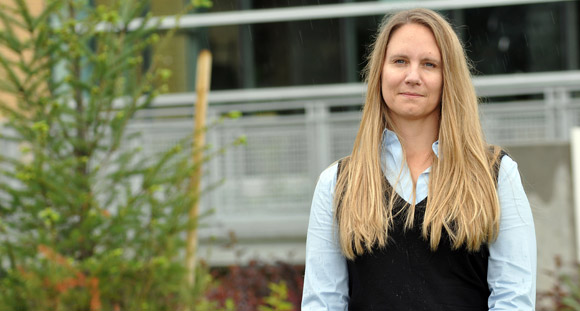
Roberta Dyck
Investigating chemical reactions may improve workplace health for lifeguards
It’s a well-known fact that pools are full of chemicals. And researcher Roberta Dyck says people should know about the chemical reaction that occurs when those agents mix with substances already in the water and those brought into the pool by swimmers.
A mini chemical cocktail is created each time a swimmer enters chlorinated water, says Dyck, who is in the second year of her engineering doctorate studies at UBC’s Okanagan campus. The combination of whatever the swimmer brings with them into the pool—sweat, urine, perfume, hairspray, deodorant, sun screen, and skin excretions—reacts with the chemicals and any naturally occurring organic material already in the water.
“Studies have shown that when we add chlorine and other disinfectants in the pool water, it reacts with these organic substances and generates unwanted byproducts that we call disinfection byproducts (DBPs),” she says.
Whether it’s water from the pool, or water for the drinking cup, DBPs tend to occur whenever we disinfect water. DBPs in drinking water have been linked with health risks such as cancer and reproductive disorders. Because of this, Health Canada has established guidelines for DPBs in drinking water.
However, Dyck says there are no regulations commonly in use in Canada when it comes to DBPs in swimming water. And that’s something she’d like to see changed.
Dyck has developed a way to estimate the total exposure of DBPs—specifically trihalomethanes—in both the air and water at pools and aquatic centres. Because of this research, she was recently named a Pacific Century Scholar. With the title comes a $10,000 research award that will be used to help fund her research.
Dyck is now investigating what happens to DBPs once they enter the human body. Her goal is to find the right chemical maintenance and operation conditions to minimize DBP exposure for swimmers and those who work at pools.
“Water tests are much easier to do than air tests, but we have to recognize that these chemicals are in the air. And when you have an indoor pool, you have lifeguards and other staff who are breathing in these chemicals each and every day. That’s why we need to develop guidelines.”
The model was developed using data previously collected from samples from 15 swimming pools in Quebec City by researchers at Laval University, as well as data—air and water concentrations for five pools in Italy—provided by Italian researchers.
Rehan Sadiq, associate professor of Engineering at UBC’s Okanagan campus, says he is not surprised Dyck won such a prestigious award. She’s hardworking, has a mission, and he says Dyck won’t stop until she’s satisfied she has all the answers.
“Roberta is one of the best students in my research group,” Sadiq says. “She is an extremely committed and focused researcher. I am confident that her research will make a huge impact in her field of research, as well as on developing health-based guidelines for swimming-pool operations in Canada and around the world.”
Dyck’s research is funded by Natural Sciences and Engineering Research Council of Canada, and supported by Sadiq, as well as Manuel Rodriguez from Université Laval. The research is an international collaboration with contributions from Guglielmina Fantuzzi, Elena Righi, and Gabriella Aggazzotti from the University of Modena, Italy, and Robert Tardif from the University of Montreal.
And Dyck, who stresses that public pools are safe and takes her children regularly to the local rec centre, continues to be excited by her research and her goal to improve air and water quality at pools.
“No one else in Canada is doing this type of research and when you think of all the swimming pools, I find that surprising,” she says. “This is a good example of risk management when it comes to pools and the health of people who work at them. And it is research that nobody has touched.”
— 30 —